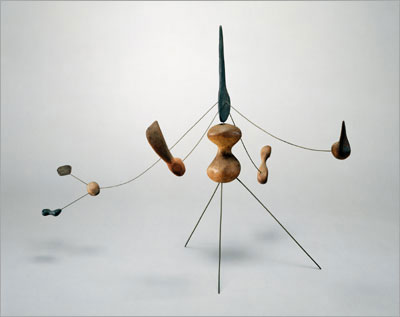

Alexander Calder, Constellation
Calder credited his initial interest in abstraction - "the shock that started things" - to his first visit to Piet Mondrian's studio in 1930, where colored rectangles of cardboard pinned to a pristine wall gave him the idea of similar forms oscillating.
In 1951 he further clarified a position he had held for decades when he wrote "the underlying sense of form in my work has been the system of the universe - the idea of detached bodies floating in space - some at rest while others move in peculiar manners, seems to me the ideal source of form."
Indeed, the solar system was foremost on his mind when he commenced in the 1940s a series of delicate sculptures that paralleled similar thematic explorations in the paintings of Miró and Tanguy. Marcel Duchamp christened these works "Constellations." Composed of small abstract forms carved from wood that are carefully arranged in three dimensions, they are extremely delicate, and suggest the "heavens in constant motion." Whether standing on platforms or floating from the ceiling, they bridge the gap between the abstract and the representational camps of Surrealism in a distinctly original manner.
Calder experimented with a number of materials to express his visions of celestial phenomena. Croisière (1931) consists of two wire circles arranged in perpendicular fashion to create an implied sphere with an unanticipated movement. Watercolor drawings from the early 1930s treat themes on the planets and movements in space. And Double Helix-one of a series of works in bronze cast in 1944-suggests the subtle movement of rotating spheres and mobiles.
